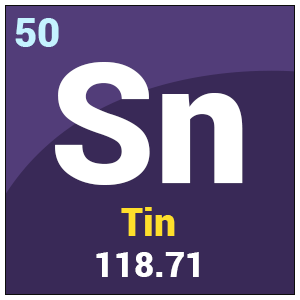

Tin or lead soft solders typically consist of more than 60% tin.The toxic organic tin compounds are widely used as fungicides and biocides stabilizers for polyvinyl chloride, and fire retardants.The coils of superconducting magnets are commonly made of niobium-tin compound (Nb 3 Sn).Some toothpaste and mouthwashes contain stannous fluoride (SnF 2 ).

Tin foil is a commonly used everyday product made of tin for the preservation and storing of food.In addition, such tin plate is also applied in electric circuits, babbitt metal, dental amalgams, pewter, and bell metal Tin cans are typically made from tin-coated steel. This method of storing food was first patented in 1839 by the English merchant Peter Durand.

Tin alloys are commonly used for plating steel cans used for packaging and storing food.Tin (Sn) is one of the most versatile chemical elements that can be used in numerous instances of everyday life: Small amounts of tin have also been found in the United States, mainly in Alaska and California. These countries form the ‘tin belt’ of locations where tin ores are naturally found. The world’s largest tin mines are located in China, Peru, Bolivia, Indonesia, Thailand, and Malaysia. After this step, tin is further refined to a tin metal of high purity (>99%) by boiling, electrolysis, or liquidation. This chemical reaction produces low purity tin and CO 2 gas. It’s smelted at temperatures of up to 2500☏ (1370☌) with carbon. This post-transition metal can be also extracted from a few other tin-containing minerals, such as teallite, cylindrite, tannite, canfieldite, and franckeite.įor commercial purposes, tin is mainly obtained by reducing the ore with coal in a furnace. Naturally occurring tin can be found in the ore labeled as cassiterite (tin(IV) oxide). Since tin ore is resistant to weathering and the tin oxide (SnO 2 ) is insoluble, there is low absorption of element 50 in both soil and waters. In the Universe, element 50 occurs as a product of neutron absorption. There’s about 0.001 percent of tin in Earth‘s crust. It can be prevented by small amounts of copper, lead, antimony, bismuth, silver, or gold, which naturally occur in the commercially produced tin. “Tin pest” refers to the reverse transformation that occurs rapidly at low temperatures. This transition of the pure, elemental form of tin occurs when this chemical is exposed to a temperature below 13.2oC. This brittle form of tin is conveniently labeled as rhombic tin (Sn). When molten tin cools down, the third allotrope of this element forms in rhombic crystals. While white tin is the form of element 50 which is widely used in everyday life, the gray form is a non-metallic allomorph of this chemical that occurs in a form of a powder. There are two basic allotropes of tin metal: white tin (Sn) and gray tin (Sn). Tin displays strong anti-corrosive properties, even when it’s exposed to seawater, distilled, or tap water. This member of the post-transition metals family of elements has an electronegativity of 1.8 according to Pauling, whereas the atomic radius according to van der Waals is 0.162 nm. With the periodic table symbol Sn, atomic number 50, atomic mass of 118.69 g.mol -1, and electron configuration 4d 10 5s 2 5p 2, tin is a soft, pliable, and easily malleable silvery-white metal. Used in steel cans, solder, bronze, pewter, and toothpaste
Chemical and Physical Properties of Tin Property


 0 kommentar(er)
0 kommentar(er)
